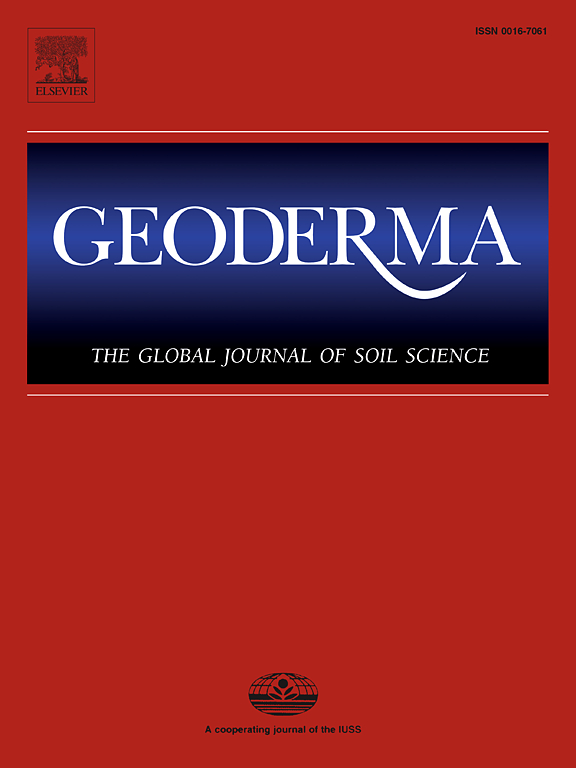Field experiment reveals varied earthworm densities boost soil organic carbon more than they increase carbon dioxide emissions
IF 5.6
1区 农林科学
Q1 SOIL SCIENCE
引用次数: 0
Abstract
Earthworms play crucial roles in regulating soil organic carbon (SOC) and greenhouse gas emissions in forest soils. Laboratory studies have proven that they promote soil carbon dioxide (CO2) emissions. However, the effects of earthworm activity on forest soil CO2 emissions and organic carbon (C) have not yet been quantified in situ, and the impact of different earthworm densities remain unclear. In this study, we investigated how earthworm (Pheretima guillelmi) activity at three densities (no earthworms, original density, and double the original density) affected SOC, its labile fractions, C-related enzyme activities, and soil CO2 emissions in a Moso bamboo (Phyllostachys edulis) forest ecosystem over a six-month field experiment. Our results showed that the original earthworm density resulted in a 23.4 % increase in soil CO2 emissions, while double the original earthworm density resulted in a 9.6 % reduction in emissions compared to the original density. Additionally, earthworms at both densities significantly increased the concentration of SOC and its labile fractions. Notably, the increase in SOC density (SOCD, SOC stock per unit land area, kg C ha−1) induced by earthworm activity far exceeded the increase in CO2-C emissions. Specifically, the earthworms at double the original density led to an 8.8-fold increase in SOCD, while the original density resulted in a 3.7-fold increase. Furthermore, our findings identified dissolved organic C (DOC) as the most critical labile organic C fraction influencing soil CO2 emissions associated with earthworm activity, while β-glucosidase (BG) was the most significant C-related enzyme affecting soil CO2 emissions driven by earthworm activity. These results provide important insights into the role of earthworms in both CO2 emissions and SOC accumulation in subtropical forests.

田间试验表明,蚯蚓密度的变化对土壤有机碳的促进作用大于对二氧化碳排放的促进作用
蚯蚓在森林土壤有机碳(SOC)和温室气体排放调节中起着至关重要的作用。实验室研究已经证明它们促进了土壤二氧化碳(CO2)的排放。然而,蚯蚓活动对森林土壤CO2排放和有机碳(C)的影响尚未就地量化,不同蚯蚓密度的影响仍不清楚。在为期6个月的野外试验中,研究了3种密度(无蚯蚓、原始密度和双倍原始密度)下蚯蚓活动对毛竹林生态系统有机碳、其不稳定组分、碳相关酶活性和土壤CO2排放的影响。结果表明,原蚯蚓密度导致土壤CO2排放量增加23.4%,而原蚯蚓密度增加一倍导致排放量减少9.6%。此外,蚯蚓在两种密度下均显著提高了土壤有机碳及其不稳定组分的浓度。值得注意的是,蚯蚓活动引起的有机碳密度(SOCD,单位土地面积有机碳储量,kg C ha−1)的增加远远超过CO2-C排放的增加。具体而言,蚯蚓在原密度的两倍时,SOCD增加了8.8倍,而原密度增加了3.7倍。此外,我们发现溶解有机C (DOC)是影响与蚯蚓活动相关的土壤CO2排放的最关键的不稳定有机C组分,而β-葡萄糖苷酶(BG)是影响蚯蚓活动驱动的土壤CO2排放的最显著的C相关酶。这些结果为蚯蚓在亚热带森林二氧化碳排放和有机碳积累中的作用提供了重要的见解。
本文章由计算机程序翻译,如有差异,请以英文原文为准。
求助全文
约1分钟内获得全文
求助全文
来源期刊

Geoderma
农林科学-土壤科学
CiteScore
11.80
自引率
6.60%
发文量
597
审稿时长
58 days
期刊介绍:
Geoderma - the global journal of soil science - welcomes authors, readers and soil research from all parts of the world, encourages worldwide soil studies, and embraces all aspects of soil science and its associated pedagogy. The journal particularly welcomes interdisciplinary work focusing on dynamic soil processes and functions across space and time.
 求助内容:
求助内容: 应助结果提醒方式:
应助结果提醒方式:


